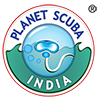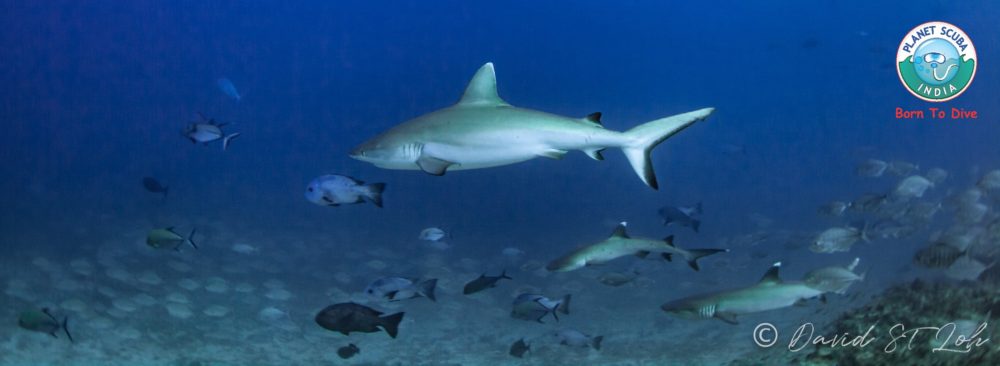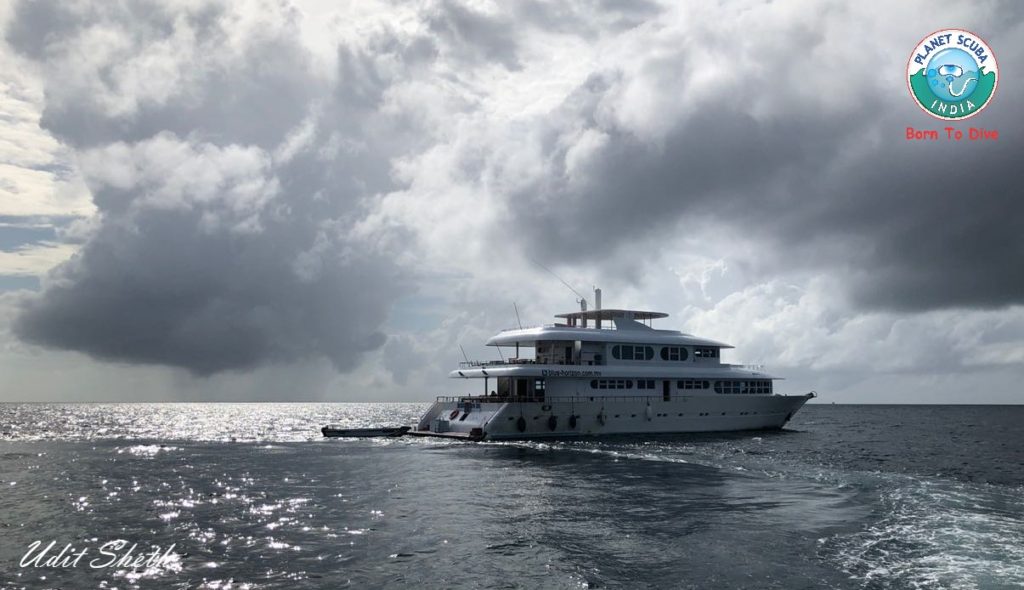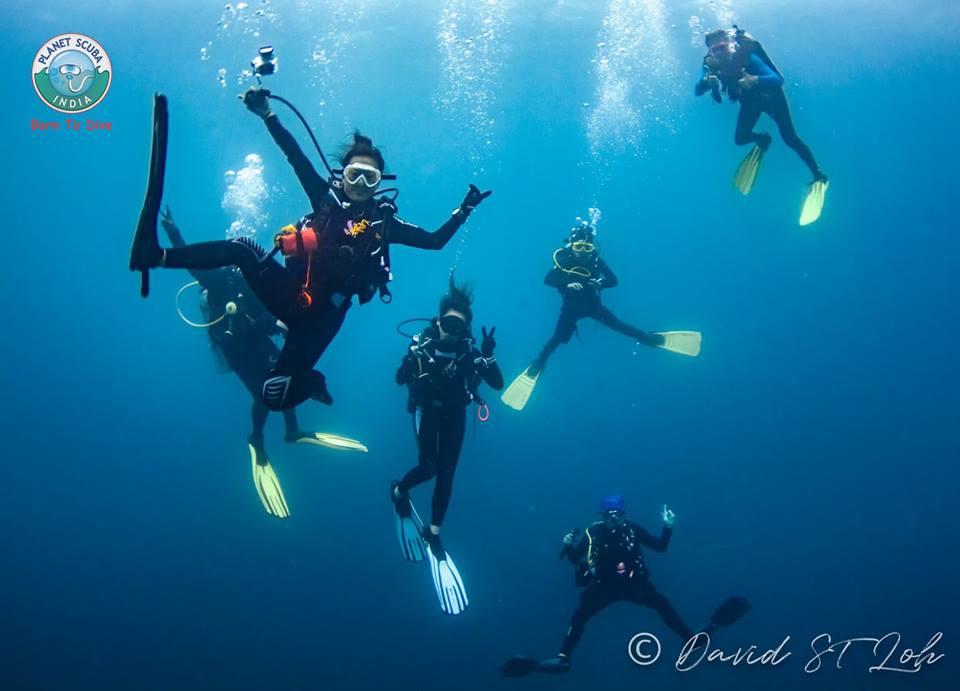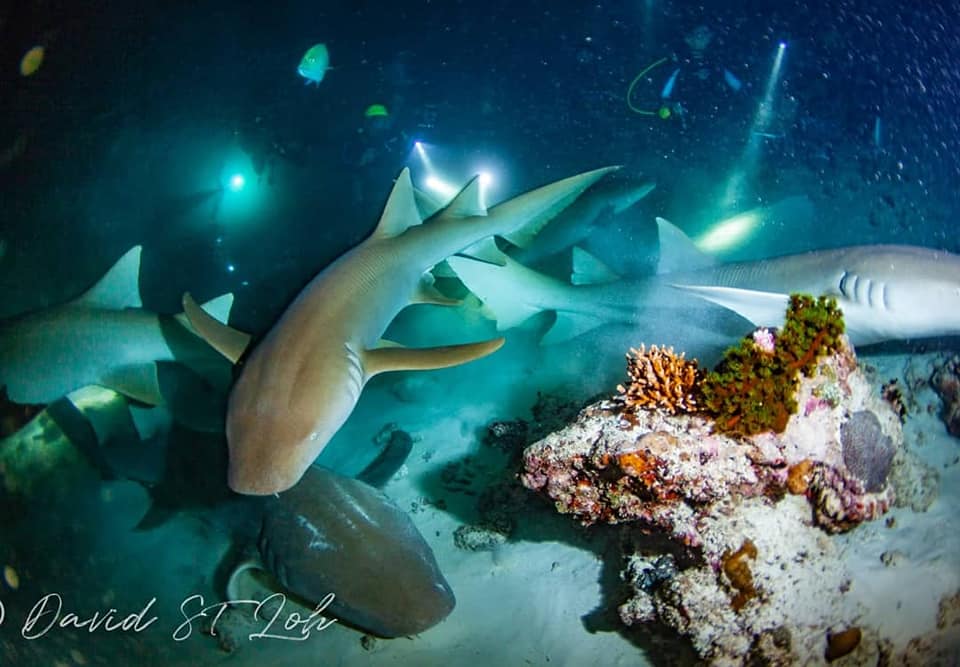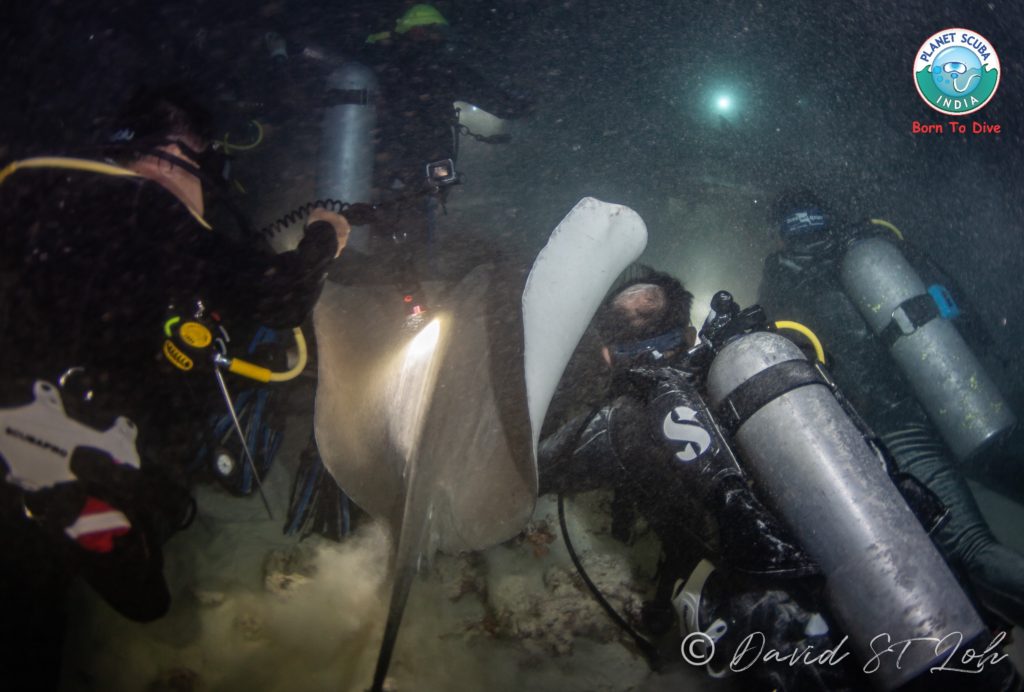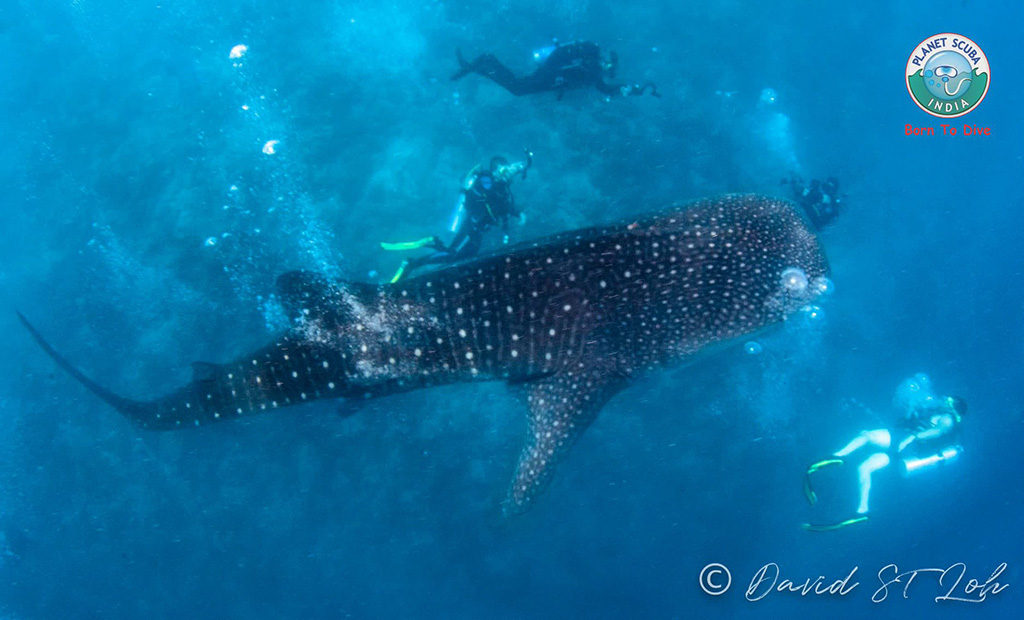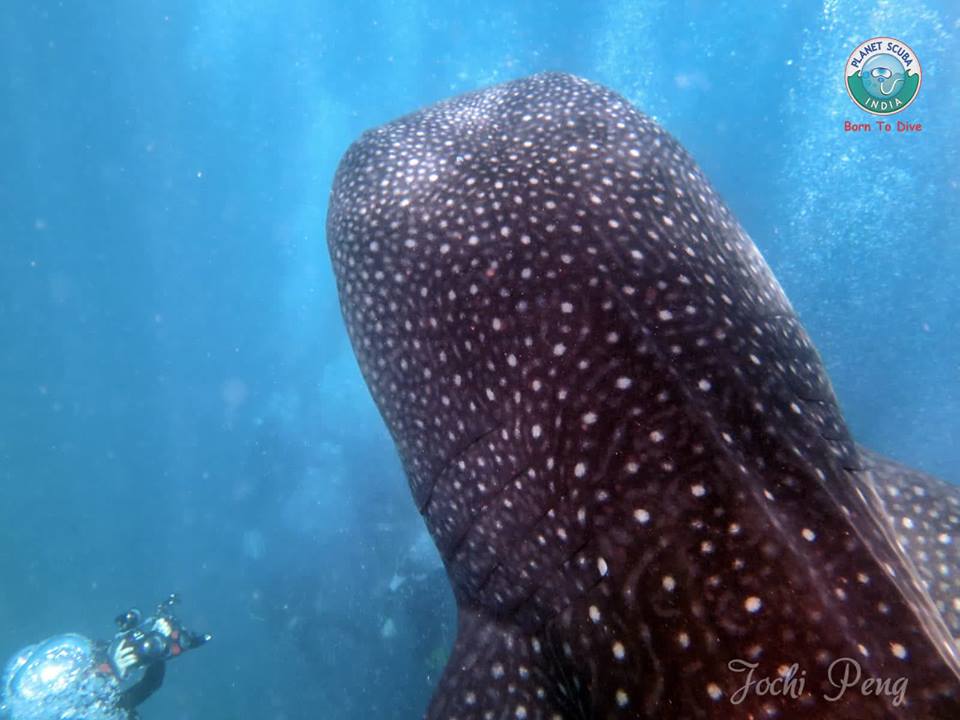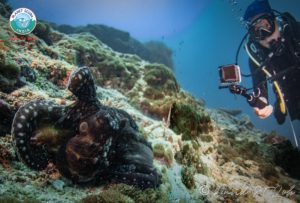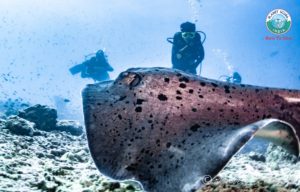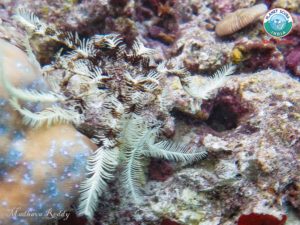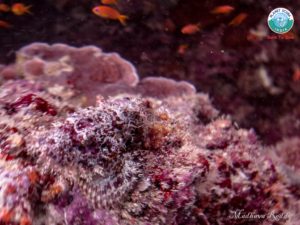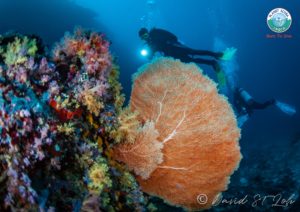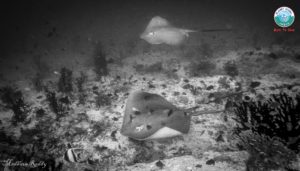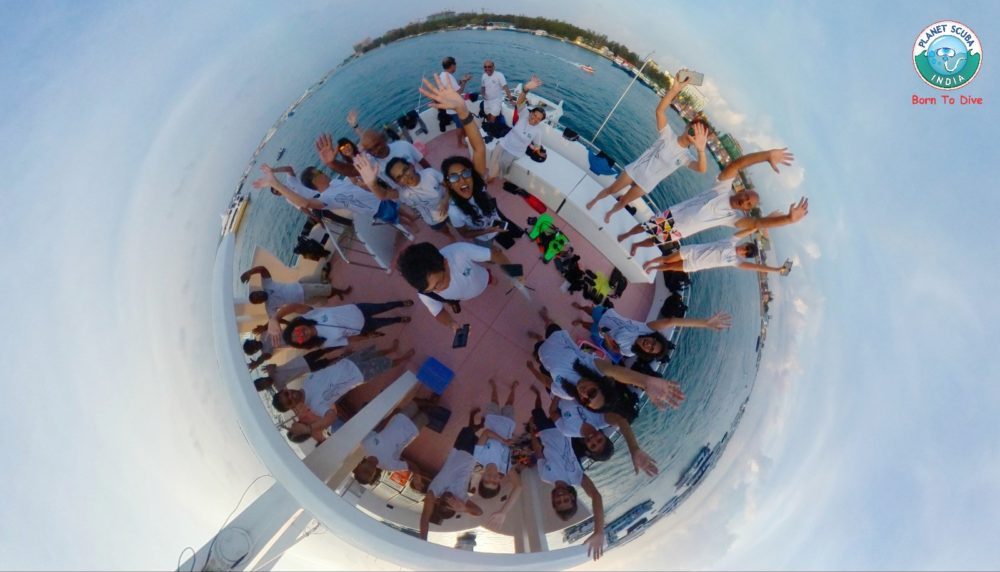When most people think about scuba diving, they picture vibrant coral reefs, sea turtles and fascinating marine life. And though, these are definite reasons to go scuba diving, they are not all that diving has to offer. Did you know that scuba diving has a multitude of positive health benefits? Yes, we are talking of scuba diving for Fit India! Some of the scuba diving health benefits are derived from the physical activity it entails. But there are also proven mental health benefits. In fact, you might be surprised to learn just how far reaching the effects of scuba diving are on both your physical and mental well-being.
Scuba Dive for Fit India & A Healthier You
Here are just a few key benefits you experience when you go scuba diving in India:
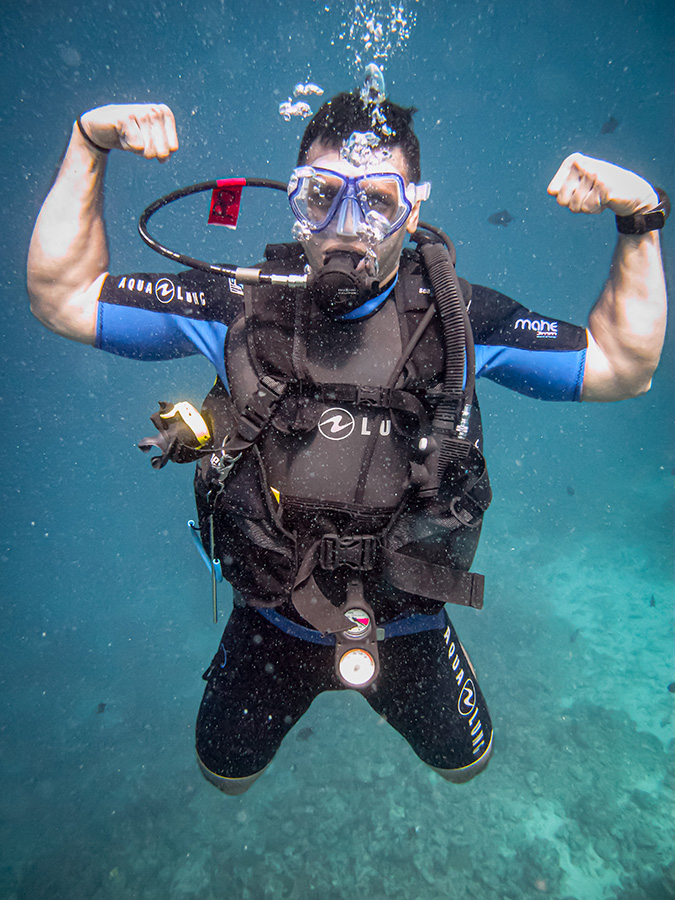 1. It improves your breathing and respiratory system.
1. It improves your breathing and respiratory system.
Scuba diving encourages divers to take long, slow, deep breathes. A calm, slow breathing pattern reduces the risk of a lung-expansion injury while diving. But did you know that it also helps reduce mucus build up?! This breathing pattern has also been known to help with existing conditions, such as asthma. The breathing technique used during diving is similar to that used during some styles of meditation, including yoga. It helps slow down your heart rate, promoting a state of peacefulness. Slow rhythmic breathing can also have a calming effect on your psyche.
2. It increases your fitness levels, strength and flexibility.
Have you heard of resistance training? When you go scuba diving, you’ll be doing that too! Your muscles have to work harder underwater than they would on land due to the increased resistance caused by the water around you. The level of resistance increases significantly when you are swimming against even a mild current. That’s why we recommend scuba diving for Fit India. The more you dive and swim, the more your muscles begin to strengthen. And you’ll also develop endurance as well as flexibility. Scuba diving and swimming doesn’t only give your legs a workout. It can also help build up your core strength, which is important for a good overall posture.
3. It lowers your blood pressure
Remember the first time you went underwater? In all likelihood, you would have experienced a spike in blood pressure. Most divers do, due to the excitement and adrenaline. But this is usually only a temporary increase. Once you have recovered from the initial spike, your heart rate reduces, so does your blood pressure. The slow and deep breathing technique you learn helps lower your blood pressure and keeps you calm throughout the dive.
4. It introduces you to the spectacular marine life underwater
Seeing stunning coral reefs and a fabulous array of fish and critters is enough to put anyone in a good mood. Also, it has been proven that seeing certain colors can affect the brain in many different ways. Scientists believe that being subjected to bright, intense colors, similar to the ones we might find surrounding reefs, can promote feelings of happiness. It can uplift your mood. In addition, the color blue has been known to induce a calming effect on the body.
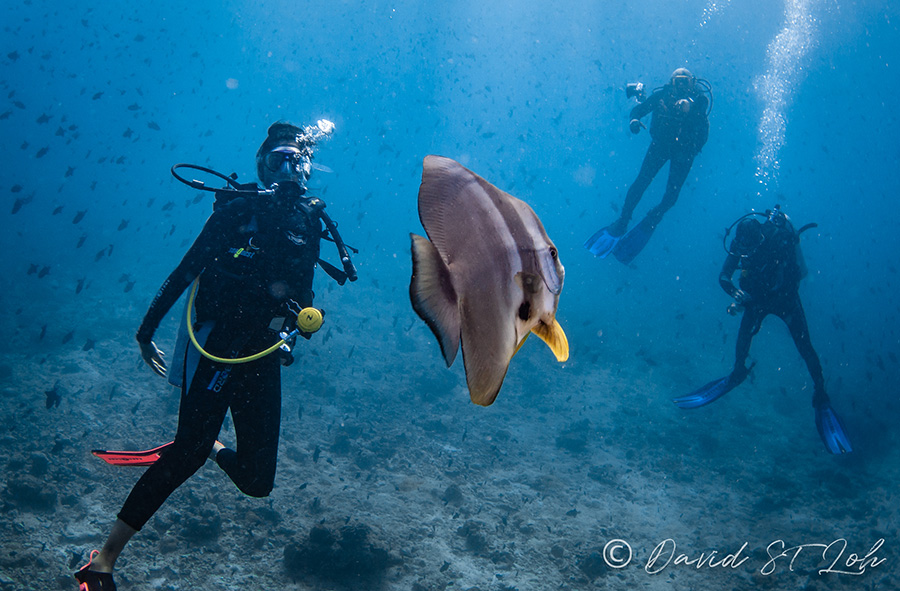 5. It encourages you to travel around the world on an adventure
5. It encourages you to travel around the world on an adventure
Yes, it is possible to dive virtually anywhere on the planet that has a body of water. However, divers tend to travel more than they dive at home. Traveling overseas, exploring and taking time off work, all lead to adventures, excitement and positive experiences. All of which are good for your body, mind and soul. Infinitely much better than being stressed, bored and stuck in a rut, don’t you agree?!
6. It provides you with the healing effects of water
Being underwater has many healing benefits. The likeness to being in the womb is believed to promote feelings of security, well-being and happiness. In addition, being in salt water for long periods of time can cause your body to dehydrate meaning that you tend to drink a lot more after the dive. This in turn means that you are replenishing your cells. You are receiving all the benefits of water both externally and internally.
7. It exposes you to sunlight
Being exposed to sunlight creates vitamin D. Vitamin D helps the absorption of calcium, which in turn keeps bones healthy and strong. Exposure to sunlight also helps increase endorphin production. Now you know why we scuba divers are a happy lot.
8. It has socializing benefits
Diving is a social activity. It involves diving with a buddy. And among divers, we find like-minded people with a common interest. There is a sense of community. A sense of being part of a ‘tribe’ when spending time with other divers. All of which are positive feelings and good for your mental well-being. Did we mention that it also helps lower stress, building confidence and gives you a sense of security and belonging!
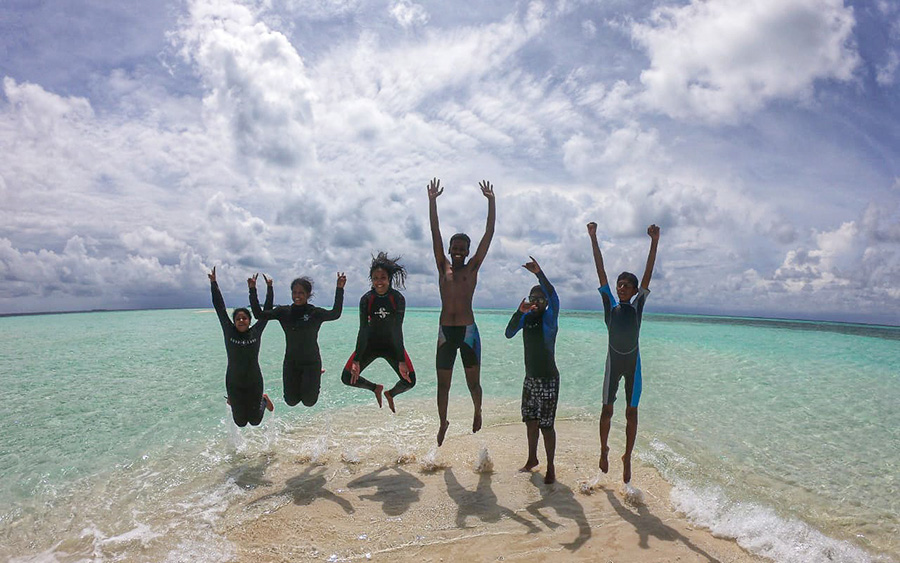 9. It is a great stress reliever
9. It is a great stress reliever
We have mentioned it earlier that the breathing pattern for diving is similar to a meditative breathing pattern. Meditating is a great remedy for stress too. Slower breathing promotes calmness. Not just that, but when we are diving, we are focused on the environment around us which enables us to completely forget work, family, relationships or financial issues. Having this mental ‘time out’ gives the body a chance to rest. It brings the nervous system back to its natural balance. Studies have shown that a relaxed and calm mind promotes a positive mental attitude. It helps you deal with your issues in a calm and rational manner. It reduces feelings of depression.
Corona Virus & Fitness
There are many uncertainties and unknowns surrounding the Corona Virus pandemic. But one thing that is widely believed to be true is that the effects of COVID-19 are generally less severe in a person who is physically healthy and fit. We know, you may not cherish the thought of going to the gym to work on your fitness, but how about going diving instead!
Scuba Diving in India
At Plant Scuba India, we are following recommendations regarding scuba diving health and hygiene standards. We have new procedures in place to ensure that gear is disinfected and all recommendations are being met. If you have tested positive for COVID-19, you will require a doctors medical clearance, as a precautionary measure, prior to participating in any in-water activities. Contact us by email and we can provide you with a form for your doctor to sign.
If you’d like to learn to dive or to join us for fun diving in India, or if you have any questions about scuba diving for Fit India, health and diving, or corona virus and diving, contact us on: holidays@planetscubaindia.com.
We look forward to diving with you soon!
Text: Sarah Ann Wormland, PADI
Photos (in order of appearance): Madhava Reddy, David ST Loh, Gopala Krishnan
Dive India & Advance Your Scuba Skills
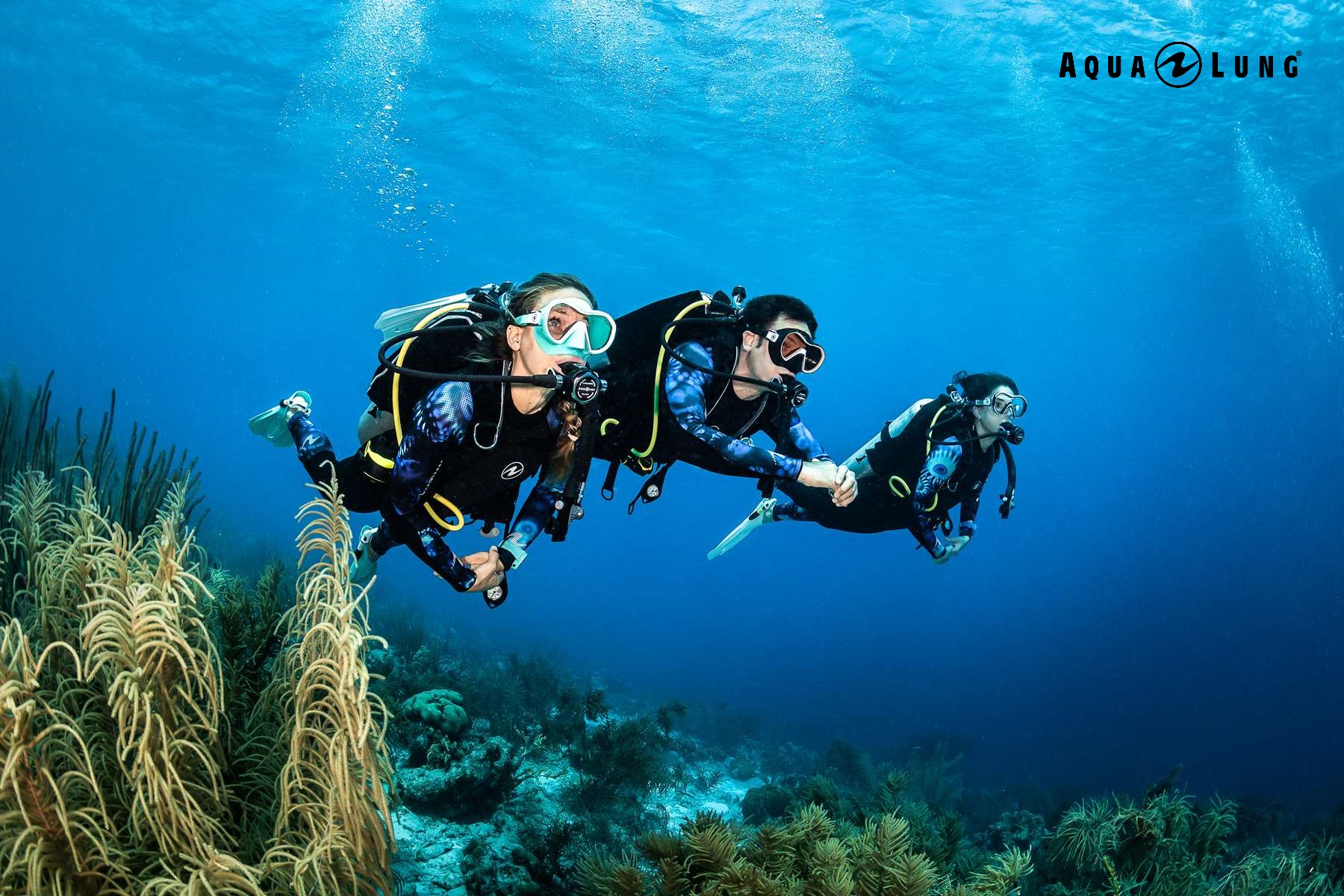
Did you ever dive in India? Are you a certified diver who wants to develop your skills, learn new ones and become a more confident diver? Are you trying to decide between taking a core PADI course or a specialty?
The good news is that as a certified diver you have plenty of options to dive in India. We have a diverse range of sites in our country for you to explore; all while you develop your skills and learn new techniques.
Deciding on which course to take next depends on your current certification level. It also depends on your interests and what you want to get out of the program.
If you are a PADI Open Water Diver, the next course for you is the PADI Advanced Open Water Diver course. This is our recommendation for all Open Water Divers who want to dive India or anywhere else in the world! You’ll make 5 incredible dives with your instructor, including a deep dive and underwater navigation. The other three dives are yours to choose from a wide range of options. In fact, you can start learning most of the courses from home straight away! Get in touch with us to know how.
For those who are already Advanced Open Water certified, the next step is the PADI Rescue Diver Course. Do you want to become a PADI Divemaster or Instructor? Then you’ll need to become a PADI Rescue Diver first. It is a requirement for all pro courses.
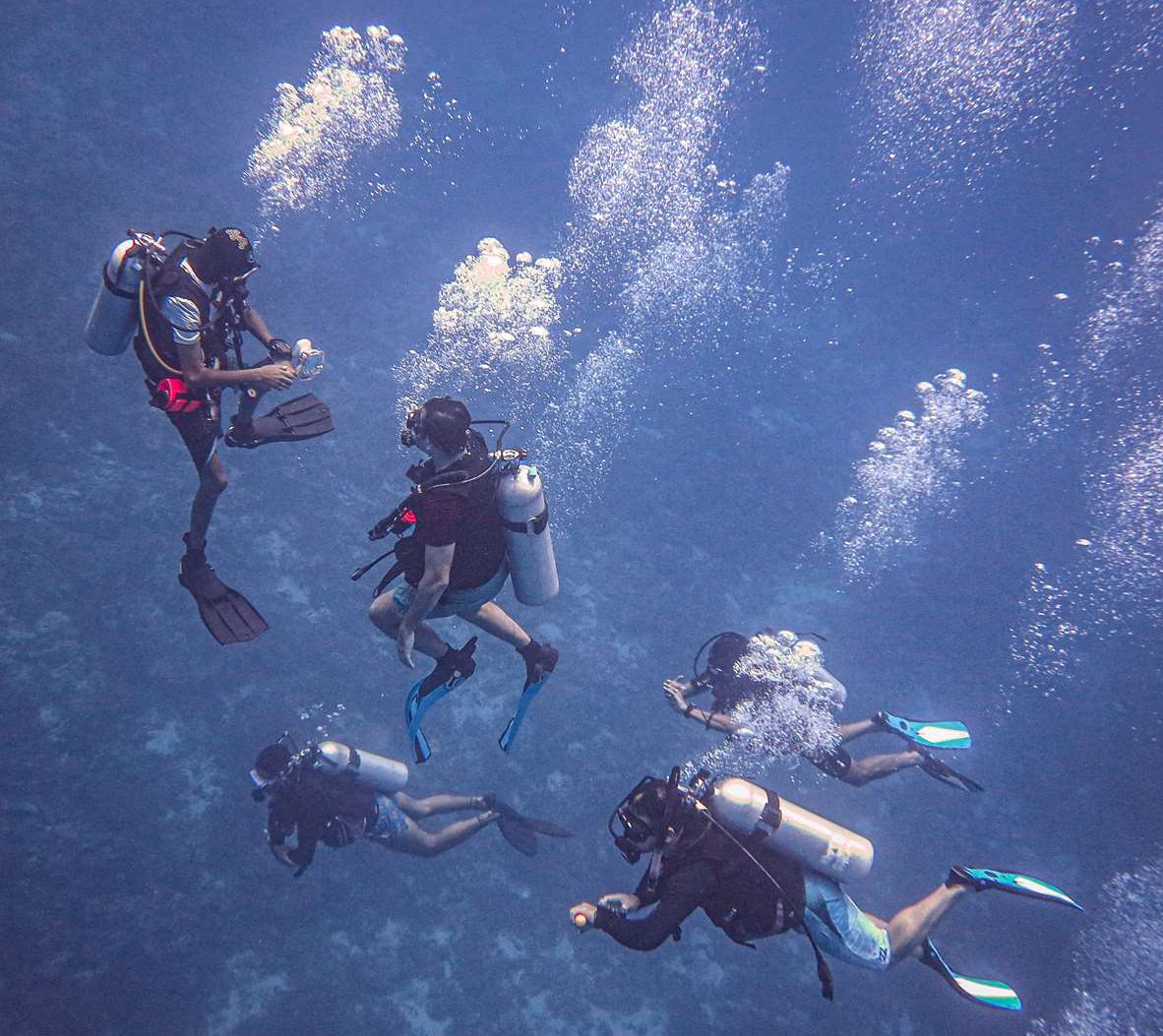
Here are some other programs that might be of interest to you when it comes to developing specific skills…
Reactivate:
With the current Covid-19 situation, in all probability, it has been a while since your last dive. Do you want to recap some of the essential basic underwater skills before moving on? No problem, the PADI reactivate program is specifically designed for this purpose. It will get you back in the water and make you feel confident about your abilities!
Enriched Air Specialty:
It seems so unfair when you have plenty of air left and your computer tells you to shallow up. Ever wished you could stay deeper for longer? Diving with Enriched Air (Nitrox) increases your allowable bottom time. This means you can admire the depths of your favorite dive sites in India, for longer!
Emergency First Response:
This program is a complete CPR and first aid course. It is mostly known by its abbreviation: EFR. The course deals with all aspects of emergency assistance, not just those related to diving. You’ll learn about handling accidents at home and in other daily situations too. Topics covered include CPR, spinal injuries, serious bleeding, choking, shock, splinting… It also includes first aid assessments and many more techniques that can extend a patient’s life. This is a great certification for anyone as it teaches essential lifesaving skills.
PADI Divemaster:
Are you already a PADI Rescue Diver? Thinking of a career in the scuba diving industry in India? Then the PADI Divemaster Course is your first step into professional diving! Unlike other PADI Courses, you’ll be mentored and work alongside your instructor. You’ll gain insight into the workings of the industry and behind-the-scenes at a dive center. You’ll also develop the skills required to assist PADI Instructors with PADI courses. And also learn how to guide certified divers independently.
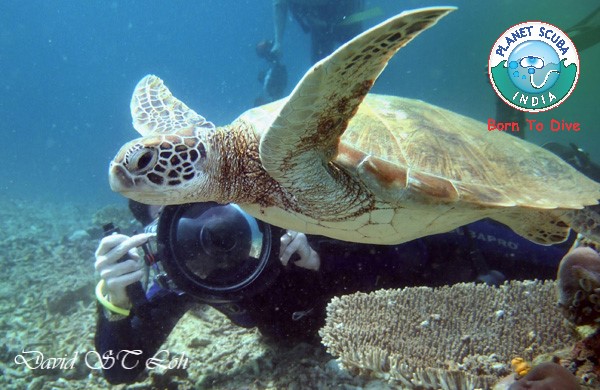
Digital Underwater Photography Specialty:
It’s hard to explain to non-diving family and friends about some of the beautiful life we see underwater. But with amazing images, you don’t need to! Master the techniques required to produce sharper and more colorful images which will impress your buddies and land-loving friends! The best part is that you don’t have to travel too far to get fabulous photographs. There are many sites that you can dive in India too for some amazing clicks and memories.
Other PADI Specialties:
Is there a particular type of diving you want to learn more about? We also offer a full range of PADI Specialty Courses. These allow you to learn more and develop knowledge in specific aspects of diving. Here’s the list of additional PADI specialty courses: Boat Diver. Deep Diver. Drift Driver. Night Diver. Peak Performance Buoyancy. Search & Recovery Diver. Underwater Naturalist. Underwater Navigation. Wreck Diver.
Are you feeling inspired to take your diving to the next level? For more information, send us a message through our online contact form. Or you can email us at: holidays@planetscubaindia.com and we will get right back to you!
By Sarah Wormald, PADI
Best Scuba diving in India: the top dive sites
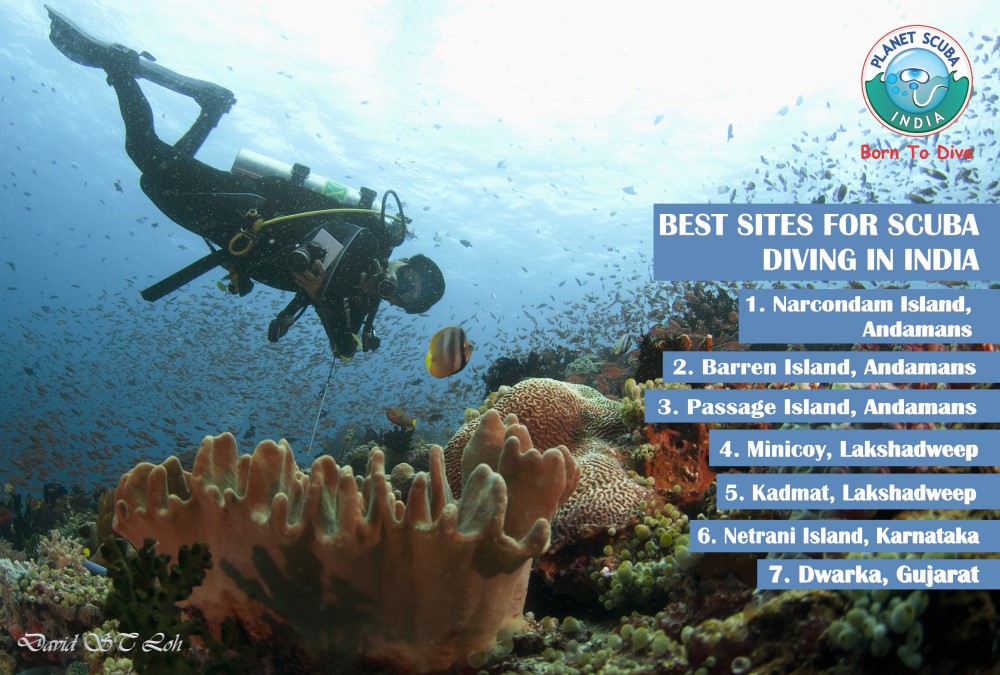
Here are seven of the best sites for scuba diving in India Planet Scuba India recommends that should be on your bucket list this year. Scuba diving in India has explored less than one per cent of the country’s more than 8,000 km coastline. By virtue of their geography, the archipelagos of Lakshadweep and Andaman and Nicobar are the gems of world class diving. Followed close on their heels by Dwarka. The lost city of legend that could well rewrite history as we know it! And then, there is the heart-shaped island in Karnataka. Adored by divers for its tranquil waters and rich marine life. From whale shark sightings to macro photography, scuba diving in India offers a plethora of options, for both beginners as well as advanced divers.
1. Narcondam Island, Andamans
Ooh La La—a quirky name for a site for scuba diving in India. But then, everything about Narcondam prompts the expression. Located around 256 km to the northeast of Port Blair, this volcanic island in the Andamans is covered in dense forests. Its lush green peak that rises from brilliant blue waters forms a rather picturesque contrast. But it is the panorama below the waves that interests scuba diving enthusiasts. Especially since it was none other than the father of scuba diving, Jacques Cousteau, who put this island on the diving map.
Scuba diving sites: Ooh La La and Lighthouse Reef. These scuba diving sites at Narcondam feature rocky ledges and steep slopes. These are replete with colorful hard and soft coral, huge barrel sponges and large sea fans. The clear waters offer visibility of up to 25 meters. Depths here exceed 30 meters.
Marine attractions: Schools of bumphead parrotfish, surgeonfish, fusiliers, snappers, angelfish and a variety of brightly hued reef fish. The deep waters also increase sightings of pelagics. Yes, one can expect to see manta rays, eagle rays, Napoleon wrasses, tunas, big-eyed travellies and grey reef and whitetip sharks.
2. Barren Island, Andamans
Scuba diving near an active volcano! The mere thought is enough to give you an adrenaline rush. Now couple that with the fact that the volcano dates back 1.6 million years. Packed your diving gear yet?! Barren Island in the Andamans lies on the edge of the India-Burma tectonic plates. And has earned a reputation worldwide for having some of the best sites for scuba diving in India. The underwater world here is a series of juxtapositions: clear blue waters, dark black soil and colorful reef life. Not to forget that surface intervals offer splendid sights of a smoking volcano.
Scuba diving sites: Purple Haze. Thus named to reflect a 50-meter-wide area covered in soft purple corals. Black Magic has sand divers and moray eels peeking out of a bed of black sand. Other scuba diving sites here include Manta Point, Coral Garden, Auditorium & Gallery and Manta Bay. You can spot that manta ray circling 25 meters away. Most dive sites have depths of more than 30 meters.
Marine attractions: Manta rays! Yes, we know we mentioned them already. Moray eels, turtles, octopus, whitetip and blacktip sharks. Also, barracudas, travellies, dogtooth tuna, needlefish, parrotfish, and a multitude of reef fish. Oh, and whale sharks are occasionally spotted at some of the dive sites here too.
3. Passage Island, Andamans
High on our list of best sites for scuba diving in India is the uninhabited Passage Island. Here the waters attract pelagics aplenty! Located about 53 km south of Port Blair, this island boasts an offshore pinnacle called Fish Rock. A scuba diving site that, true to its name, is teeming with fish life.
Scuba diving sites: Barrel sponges, large orange fan corals and clusters of soft corals cling to the rocky reef of Fish Rock. This dive site slopes down to more than 30 meters.
Marine attractions: Bumphead parrotfish crunch on corals. While barracudas and surgeonfish swirl around in schools. Yellowback fusiliers, bluestripe snappers and bannerfish paint the waters in their vibrant hues. Moray eels peek out from under rocks. The bolder ones, at times, can be seen draping themselves on fan corals. Also making an appearance are groupers, turtles, rays, Napoleon wrasses and dogtooth tuna.
4. Minicoy, Lakshadweep
Every diver we know of gets all dreamy-eyed about scuba diving in the Maldives. Enter Minicoy, the island located at the southernmost tip of the Lakshadweep archipelago. Which is just an Eight Degree Channel separation from the Maldives, as per the Admiralty Charts. Minicoy offers the most spectacular sites for scuba diving in India. Not least of which are the three large shipwrecks at around 8 meters depth on the island reef. Allegedly, it was these shipwrecks that lead to the construction of the lighthouse on the island in 1885. Other tourist attractions on this crescent-shaped island include the large lagoon on the western side and the tiny islet on the southern tip called Viringili.
Scuba diving sites: The SS Hoechst and other shipwrecks are best described as underwater museums. Not least because they are home to a large number of fish species. Manta rays can be spotted at dive sites like Ragganmathi, Mulimatti and Rabberufarai during September and October. While Bose Point, Murambu and Boduhavaligang offer great marine biodiversity.
Marine attractions: Whitetip and blacktip sharks, rays, turtles, jacks, barracudas, tuna, sweetlips, large groupers, red snappers, black snappers, bigeye trevallies, Napoleon wrasse, humphead parrotfish… The list simply goes on and on.
5. Kadmat, Lakshadweep
This idyllic island in the Lakshadweep archipelago is just 8 km long and 550 m wide. That too at its broadest point! Kadmat promises one of the most memorable holidays for scuba diving in India. Thanks to its shallow calm lagoon, pristine beaches, crystal clear waters and rich marine life.
Scuba diving sites: The Wall, covered with soft corals, is one of the most beautiful reefs. Schools of tuna and barracuda vie for your attention. While sharks whiz past and turtles swim by at a languid pace. Other dive sites here are North Cave, Potato Patch and Shark Alley. Visibility in these waters ranges from 20 to 50 meters.
Marine attractions: Sharks, eagle rays, turtles, tunas, jacks, sweetlips, groupers, moray eels, lobsters, batfish, fusiliers, wrasses… The dive sites here are great for macro photography too.
6. Netrani island, Karnataka
The heart-shaped island is possibly one of the most adorable destinations for scuba diving in India. Netrani, located off the coast of Karnataka, is a small, uninhabited island. A rocky outcrop emerging from the Arabian Sea, approximately 10 nautical miles from Murudeshwar. The temple town that is home to the second largest Shiva statue in India. It is rated as one of the best places on the west coast for scuba diving in India. Mostly because the tranquil waters here are known to throw up unexpected surprises.
Scuba diving sites: The Nursery teems with juvenile fish of various species. While T55 is a great place to spot groupers, travellies, jacks and a sunken torpedo. Grand Central Station, The Abyss, Dini’s Delight, Cul de Sac and Aladdin’s Cave round up the list of scuba diving sites at Netrani. The clear waters offer visibility of 15 to 30 meters. Depths range from 10 to more than 30 meters.
Marine attractions: Butterflyfish, barracudas, batfish, groupers, parrotfish, surgeonfish and snappers dart into camera range. At The Abyss, cruising pelagics are a common sight. The seagrass at Cul de Sac is home to different species of goby and their cleaner shrimp.
7. Dwarka, Gujarat
Imagine scuba diving in India at a place that could rewrite world history. We are talking about the over 9,000-year-old lost city of Dwarka! The legendary dwelling place of Lord Krishna. For this reason, Dwarka finds its place on the our list of the best sites for scuba diving in India. While findings by the Underwater Archaeology Wing of the Archaeological Survey of India only reveal that ancient structures have been discovered, along with 30 copper coins. The exact date of the structures and coins are yet to be discerned.
Scuba diving sites: Tall sea sea fans, hydroids, sea anemones, the underwater city offers a varied collection of corals.
Marine attractions: To think that whale sharks can be spotted so close to home. Oh, and turtles and dolphins sightings are common in the Gulf of Kutch. You can also expect to spot octopus, pufferfish and other species during low tides at the marine sanctuary here.
The best diving holiday of 2018 in Magical Maldives
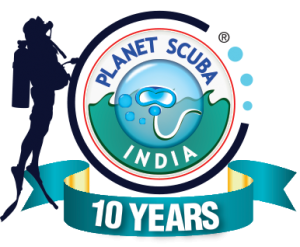 What happens when on the initial day of your scuba diving holiday itself you see manta rays and dozens of white tip and grey reef sharks? Well, the stakes just get higher for the dive guides. But then again, this is the Maldives! The tropical paradise made up of 26 atolls, with some of the best scuba diving sites in the world. And every dive here is simply spectacular.
What happens when on the initial day of your scuba diving holiday itself you see manta rays and dozens of white tip and grey reef sharks? Well, the stakes just get higher for the dive guides. But then again, this is the Maldives! The tropical paradise made up of 26 atolls, with some of the best scuba diving sites in the world. And every dive here is simply spectacular.
Scuba diving holiday in Magical Maldives
For Planet Scuba India, this was our third trip to the Maldives in 2018. And, come to think of it, it seemed like each diving holiday was trying to supersede the previous one. This time around, our liveaboard of choice was the Horizon 3. From October 7-13, this luxury liveaboard was home to 23 guests of different nationalities—Indians, Singaporeans, Taiwanese, Malaysians. Including two divers from India completing their PADI Open Water Diver course. They then went on to complete their PADI Advanced Open Water Diver course, along with three other scuba divers from India.
This diving holiday also had a couple of non-divers (who enjoyed themselves just as much, if not more) and some of the best photographers. You need only take a look at the pictures to nod in agreement.
It was six fun-filled days of eat, sleep and dive! And, of course, swapping of hilarious, unforgettable scuba diving adventures.
Here are some of the highlights of one of our best diving holidays in the Maldives.
The Manta show
First dive of the day at Lankan Manta point. This dive site, at the southeastern outer reef of Lankanfinolhu Island, is one of the most popular cleaning stations for manta rays in North Male Atoll. And, as luck would have it, on the day of our dive, the manta rays showed up in all their magnificent glory. We took a giant stride off the dive dhoni, descended a few meters, and gasped in awe (well, as much as one can gasp with regulator in mouth), as a manta ray elegantly swam past. Not knowing then that this was just a prelude of what was to come a few minutes later. Our dive guide led us to the coral blocks of the cleaning station. And, lo behold, heads swiveled in every direction as mantas glided in, out, and around in circles.
Here’s the thing about cleaning stations: they are a riot of colors. It is not just the mantas vying for attention but brightly hued cleaner fish, vibrant corals, and a motley of sea creatures. There is just so much to take in that you rue the fact that your neck isn’t able to turn more than 90 degrees. Just how are you supposed to see the cuttlefish whooshing past behind your back, when you eyes are so intensely trained on the spectacular subjects in front of you?!
Mantas come calling
Subjects that came to visit us later that night. Bang at dinnertime! Who cares about food when you can watch a manta ray circle around the back of your boat instead. Well, to be fair, it was dinnertime for the mantas too. And one somersaulted away, mouth agape, sieving marine organisms out of the water and into its stomach. Round and round it went, as 23 heads (more if you count the crew) stuck out of the sides of the boat watching in fascination. That is, till it had had its fill and glided away as surreptitiously as it had appeared.
Shark tale
Bathala Maaga Kanthila, North Ari Atoll. Even though this dive site, which we visited right after the underwater manta ray spectacle, had grey reef and white tip sharks. Not to forget, schools of yellowback fusiliers and a huge Napoleon wrasse that stole the show. It was the dive at Fish Head at North Ari Atoll that remains etched in our memory. Perhaps it was the story that did it for us. As our dive guide, Marko, told us during the briefing that at one time this was a famous fishing spot. But when the fishermen reeled in their catch, all they got was the heads of the fish. The sneaky sharks had eaten up the rest. Or perhaps it was the dive site itself. With its multiple ledges and picturesque overhangs replete with fan corals and abundant fish life.
Again, just a few meters and a few minutes into the dive, we spotted sharks right below us. Our dive guide took us on a detour, around one ledge and onto another below it. Having us swim stealthily to not disturb the unfolding drama. Sharks darted around, remoras in tow, while parrotfish hid in crevices in corals. And clownfish peeked out of anemones. Crustaceans moved a centimeter at a time to not be spotted.
It was 45 minutes of spying on sharks. Eyes wide in wonderment; cameras trained at the action. Grey reef sharks and white tip sharks, and also barracudas—all the predators at their A-game. Little wonder then that Fish Head, also known as Shark Point or Mushimasmingili Thila, is listed as one of the most famous dive sites in the world.
Night dive with nurse sharks
We just can’t get enough of sharks. Especially on night dives. Two months later, we were back during this diving holiday too to be bumped into by nurse sharks. Simply put, the dive at Alimatha Jetty, Vaavu Atoll, offers an adrenaline rush like no other. And to think that all you need to do is kneel on a sandy bottom. While nurse sharks, stingrays, travellies whip around you foraging for food. If we had to bet on a species, it would be the crafty travellies, who gulped down the food faster than the nurse sharks and stingrays could wonder: ‘where the heck did it go?’. It was a surreal experience that no amount of photographs or videos could do justice to. Though the ace photographers did manage to capture little snippets of the frenzy.
Back at the boat after the dive, and the nurse sharks came visiting. Who would have thought that after all the action underwater, there would still be so much excitement to see them. Cameras were whipped out. Facebook Lives were posted. Frantic video calls were made to friends to gloat about what they were missing.
Whale shark frenzy
There’s only one thing in the Maldives that can get divers into the water faster than you can blink. And that’s the much-awaited sound of someone screaming: ‘whale shark’! On this diving holiday, we snorkeled to see one just after our dive at Dhigurah Beyru, South Ari Atoll; a dive site that counts whale shark encounters as one of its highlights. It was a mad jumble of divers, cameras and fins, as a lonesome whale shark swam calmly, feeding its way through the waters. Seemingly oblivious to the mayhem unfolding above, for just a glance of it.
The UMS
Colloquially, UMS, or usual Maldivian stuff, is a term used to describe everything from soft corals to giant turtles. That’s because every dive in the Maldives reveals spectacular sights and secrets. Marble rays hunting together. Octopuses, tentacles intertwined, in a sort of a love-hate dance. Mantis shrimp peeking out from its coral den. Scorpionfish in perfect camouflage waiting for its prey. Turtles gorging themselves silly on sponges. Sweetlips hanging out under overhangs. Moray eels getting spruced up by banded coral cleaner shrimps. Shoals of glassfish darting in and out of a wreck. Feather starfish climbing over hard corals. Stingrays swimming in and out of camera range. Schools of bannerfish, yellowback fusiliers, batfish, red snappers just going about their day underwater. And a liveabord full of happy divers. ‘Coz you just couldn’t ask for a better diving holiday destination than the Maldives.
Maldives: A Dream Liveaboard Holiday for Scuba Divers from India
 Scuba diving in India was closed for the season, what with the rains pouring down here. So, it was an obvious choice that we, at Planet Scuba India, plan a diving holiday to the Maldives. A holiday that we will never forget.
Scuba diving in India was closed for the season, what with the rains pouring down here. So, it was an obvious choice that we, at Planet Scuba India, plan a diving holiday to the Maldives. A holiday that we will never forget.Scuba diving in the Maldives
Here there were whale sharks, manta rays, sting rays, octopus, cuttlefish, turtles, sharks, and also, as the locals call it, UMS or ‘usual Maldivian stuff’. A term that shouldn’t be shrugged off lightly, since it includes the entire range of sea creatures, from cute little clown fish to elusive moray eels and pouty Napoleon wrasses. Truly, scuba diving in the Maldives never ceases to fascinate! And it doesn’t matter how many times you have ‘giant-leaped’ into the crystal clear waters.
The fascinating underwater world
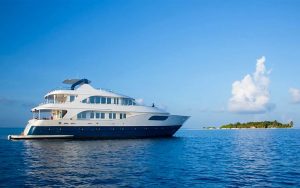
Planet Scuba India’s August 11 – 16, 2018 dive holiday on the Honors Legacy liveaboard was a breathtaking experience. Nineteen scuba divers from India headed to the tranquil waters of Ari Atoll. These included six divers completing their PADI Open Water Diver courses, and four completing their PADI Advanced Open Water Diver courses. Call it beginners’ luck, but dive after dive revealed magical surprises. The hungry whale shark happily feeding its way through the waters off Dhigurah in South Ari Atoll. Majestic manta rays sprucing up at cleaning stations. Cuttlefish getting all territorial about its mate. Turtles languidly swimming past. And then, there was the colorful and varied every day traffic of fish species that had cameras swiveling in every direction, in an underwater photography frenzy.
Night dive at Alimatha
Oh, and the night traffic of nurse sharks, by the dozens, at Alimatha resort house reef, Vaavu Atoll. We saw nurse sharks lazing around, scouring for food in the light of our torches, and scratching their bellies in the sand. While stingrays hovered around trying to grab the limelight. And a hermit crab quietly stole a mollusk shell and trotted away, hoping no one would notice. All the activity made this one of our most exciting night dives in the Maldives.
Scuba divers from India hoist the national flag
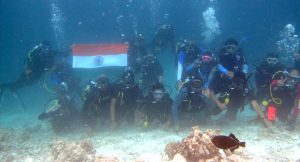
Finally, as it has been every year, on India’s Independence Day, Planet Scuba India hoisted the national flag underwater. The tricolour unfurled against the dramatic underwater landscape of colorful reefs and schools of fish, in the hands of fun scuba divers from India, enjoying their magical diving holiday in the Maldives.
